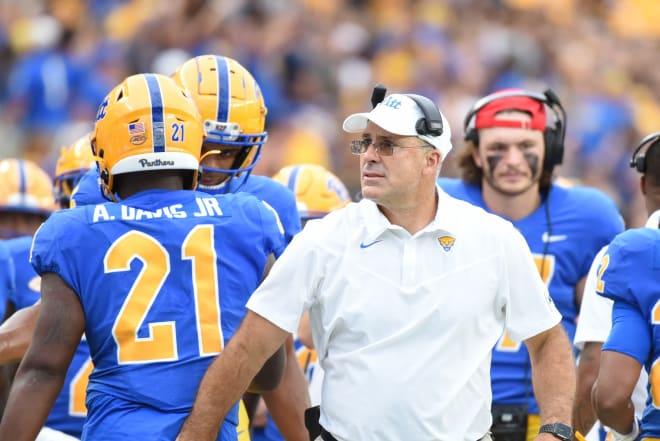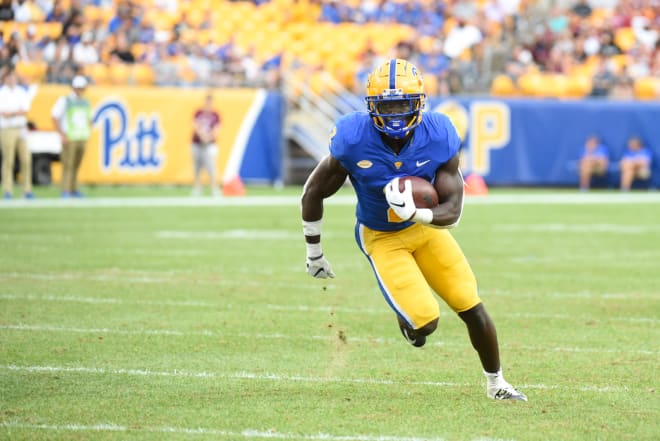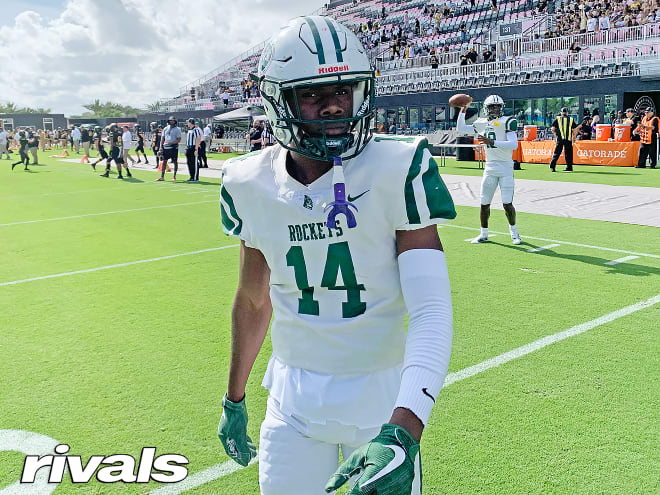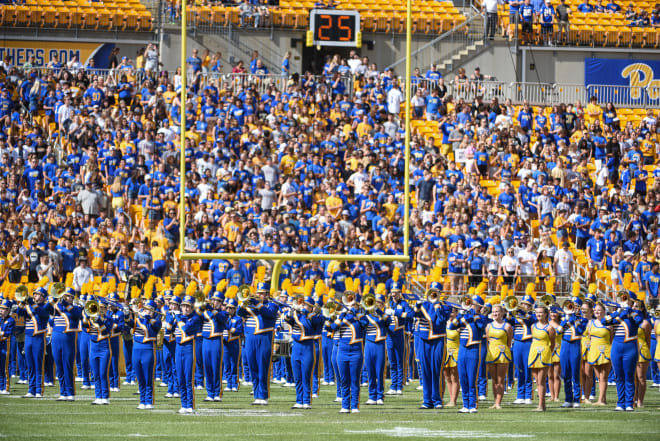The 3-2-1 Column: Recruiting importance, new commits, stadiums and more
In this week’s 3-2-1 Column, we’re thinking about the long reach of recruiting, Pitt’s 2023 class and a lot more.
THREE THINGS WE KNOW
Recruiting is always the answer
I’ve been working through Pitt’s 2022 roster for our “Anatomy of a Position” series, where we go position-by-position for an in-depth look at every spot heading into the season.
I think this series is fun, interesting and occasionally enlightening for a few reasons. For one, it puts the whole roster in front of you for your consideration. But it also brings up the history, breaking down the recruiting that led the roster to its current state.
This is a point I try to make all the time: when you want to know why a team is good or bad at any given spot, the answer is always in the recruiting. Go back through the recruiting classes, and you’ll find an explanation for pretty much everything when it comes to the current team.
Is the team deep at one position and weak at another? You’ll find the answers by looking at the recruiting classes. Who did they recruit, who panned out and who busted. The answers are all right there.
We can talk about coaches and game plans and fourth-down calls and challenges and things of that nature, but the reality is, games are decided by the players on the field. Those other things have an impact, no question, and sometimes they can have a significant impact on a game. But it’s still about the players.
So when you want to understand why a team had a successful season or an unsuccessful one, why a team is on a run or in a slump, why a coach gets a new contract or the axe, the answer is always in recruiting.
From time to time, people used to ask why recruiting was of interest to some college sports fans. It seemed to be a niche, a weird obsession for fanatics who showed too much interest in the whims of high-schoolers.
But my response was always the same: if you want to understand what’s happening with a team, you look at the recruiting. And if you’ve followed the recruiting closely enough, then you shouldn’t be too surprised by the outcomes on the field.
I know I’m preaching to the choir here. You are on this website because you care about recruiting and you know the implications it has.
But sometimes when you draw the direct line from recruiting classes straight to the on-field results, it’s really striking how strong the connection is. Pitt’s efforts in recruiting the offensive line, defensive line and defensive backfield in the classes of 2017, 2018 and 2019 led directly to the ACC championship in 2021 (the quarterback helped, too, of course).
The transfer portal has become a major factor, as we know, but roster-building is still a multi-year project, and the essence of that is in recruiting.

A good stretch at running back
When I think about positions that have - or have not - been recruited well at Pitt under Pat Narduzzi, a couple obvious candidates come to mind.
Defensive back and defensive line - those are definite for the former category. Pitt has done really well with corners, safeties, ends and tackle, and the results, both in college and the NFL, speak for themselves.
At the other end of the spectrum are the tight ends, where it’s really, really not pretty.
But I’ll tell you one spot that is low-key a strength for Narduzzi’s recruiting.
It’s running back.
That one might not come to mind right away, not as visions of A.J. Davis and Todd Sibley and Chawntez Moss and Mychale Salahuddin dance in your head. And you’d be right: those guys, who represent Pitt’s running back recruiting from 2016-18, pretty much all busted out (although Davis and Sibley spent four years with the Panthers).
But the last three classes have been quite a bit better than those three.
The class of 2019 brought Vincent Davis and Daniel Carter to Pitt. 2020 was a one-man class of Israel Abanikanda. And 2021 was Rodney Hammond.
That’s a pretty strong quartet.
Davis led the team in rushing touchdowns in 2019 and rushing yards in 2020. Abanikanda took that top spot in 2021 with Davis and Hammond right behind him as the trio combined to rush for more than 1,700 yards in a pass-heavy scheme. And Carter won the Ed Conway Award as the most improved player on offense this spring.
Scoff if you like, but I am really high on Pitt’s running backs for 2022. I think Abanikanda is a pro-caliber back who will have a chance to go to the NFL as a draft pick next spring if he stays healthy this fall. I think Hammond is a bowling ball with speed who will probably exert more effort per carry than any back on the roster. I think Davis is a unique player who can fill a unique role. And I think Carter could end up with 500 or 600 combined rushing and receiving yards.
It’s a strong group and one that spans four recruiting classes. And while three classes that came before them didn’t pan out and the class that came after is a bust, too, due to Jordaan Bailey failing to qualify, I think the hauls of Davis, Carter, Abanikanda and Hammond make for a good enough stretch to earn the coaches some credit for their recruiting at running back.
It may not be a seven-year stretch of success, but it’s good enough for me to put that position in the “strengths” category when it comes to recruiting.

A not-so-good stretch at receiver
And now we have the other side: a position where the recruiting might have been a little less good.
Receiver.
No, it’s not tight end. I mean, yes, tight end has been a struggle. But receiver is a spot where some gaps are having an impact on the current roster.
Consider that Pitt signed seven receivers in the classes of 2018-20. Of those seven, four have transferred and one has moved to linebacker, leaving just two receivers from three entire recruiting classes on the projected roster for the 2022 season.
To wit, Shocky Jacques-Louis is now at Akron and Jordan Addison is now at USC. Cameron O’Neil seems to have gone to a junior college. And Will Gipson doesn’t seem to have landed anywhere at all.
Throw in Aydin Henningham’s not-entirely-surprising switch to linebacker, and you end up with very little from the classes that should provide the third, fourth and fifth-year receivers for this year’s roster.
Granted, the departures of Addison, Jacques-Louis, O’Neil and Gipson plus Henningham’s move weren’t necessarily recruiting misses. But those losses have created some gaps that need to be filled in, because heading into the season with senior Jared Wayne, junior Jaylon Barden and sophomore Jaden Bradley as your three most experienced receivers isn’t exactly an ideal situation.
I think the Pitt coaches saw this issue even before Addison’s departure to Los Angeles. They made Akron receiver Konata Mumpfield a priority in transfer recruiting back in December. At that time, Mumpfield figured to be a No. 2 to Addison; now he’ll be the No. 1, and it’s a good thing the coaches had the foresight to pursue him.
It was also fortuitous that Pitt got Bub Means in the fold, too. He committed as a transfer from Louisiana Tech just about a week or so prior to Addison entered the transfer portal, and that became an even more valuable addition as the numbers continued to be depleted from the receiver room.
The younger classes have some promise, with Jaden Bradley looking good in his limited playing time as a freshman and Addison Copeland and Che Nwabuko having potential in the incoming group.
But those players are going to have to grow up in a hurry - if not this season, then in 2023 and beyond.

TWO QUESTIONS WE HAVE
What’s the latest on the class?
Speaking of receivers, Pitt added another one to the 2023 recruiting class this week when Lamar Seymore committed to the Panthers.
Technically, Seymore committed to Pitt at the end of his official visit in mid-June. Since then, he has formally decommitted from Miami and announced a top five, but all of that came to an end on Monday when he made his Pitt commitment public.
Seymore is the third receiver to commit to Pitt in the class, joining Zion Fowler and Kenny Johnson. Fowler was the first recruit to join the class; he committed last fall. And Johnson was something of a surprise commitment when he pulled trigger during the first official visit weekend of June.
So that’s three receivers in the class, and we know the coaches are willing to take another wideout. Hykeem Williams is the obvious top target, but I think they could pursue another receiver - even someone who’s not ranked quite as high as Williams.
Is four receivers too many in a class? I don’t think so. I just spent the last section of this column talking about how the depth at receiver has taken some hits lately, and the last two classes have only brought two receivers each to the roster.
At some point, you need to make up those numbers, even if you have done some work in the transfer portal to address the position. Given that the class of 2023 should be a larger one for Pitt, it seems like an ideal time to bring in more receivers.
I think the coaches are taking a similar approach with linebacker and offensive line, too. The class of 2023 could end up bringing as many as three linebackers and four or even possibly five offensive linemen to the roster.
Those are big numbers, but that’s what you need to do with a bigger class like this one, which should end up signing north of 20 and possibly as many as 23 recruits. If you’re going to sign that many recruits, then you need to throw numbers at positions where the depth is getting thin.
Overall, Pitt’s class stands at 18 total commitments. 16 of those have been publicly announced and two are still lurking in the shadows. I figure the class will ultimately end up around 20-23, which means 4-7 more commitments (including the two unannounced). I think that group should include one more linebacker, one more defensive end, a tight end and then some “best player available” types - even if that means at positions where Pitt has seemingly enough commitments already, like running back, receiver or defensive back.

What’s in a name?
Not much, if we’re being honest.
You saw the news early this week: Heinz Field is getting a new name. It will now be Acrisure Field.
I can tell you this:
I Acrisure don’t care.
Sorry for the pun, and I’m even more sorry to the two people I found on Twitter who made that joke before I could. But I’m sticking with something unoriginal because I think it illustrates the point of how little I care about a stadium name.
And the unoriginality is fitting because that’s all stadium names are these days:
Unoriginal.
They’re all corporate sponsorships.
I looked through all 32 NFL stadiums, and only two - Lambeau and Soldier Field - are not sponsored. Major League Baseball has a few more - Angel Stadium, Dodger Stadium, Fenway, Nationals Park, Oriole Park, Wrigley, Yankee Stadium - but they’re still the minority. In the NHL, only Madison Square Garden stands without a naming sponsor. Similarly, MSG is the only one in the NBA, too.
I know that everyone knows that cash rules everything around us and that stadium naming rights going to the highest bidder is nothing new. And I know that some of the reaction to the change from Heinz Field comes from going from what felt like a local company naming the stadium to an unknown bunch of out-of-towners putting their name on it.
To me, one corporation is the same as the next. I don’t care that Acrisure calls Michigan home any more than I cared that Heinz was from Pittsburgh. It’s all just a money grab, and the cash is green whether it comes from Pittsburgh, Michigan or Sacramento (my preferred “random California city” when I need one).
So call the stadium whatever you want. Keep saying Heinz Field if you like. Or strive for accuracy and adapt to the name change. I can say with full and unfettered certainty that the name of the building will have zero impact on my experience there, save for having to remember which name to type when I'm writing articles. And even that transition should get smoother after the first few times.

ONE PREDICTION
Another good year at tight end coming
To me, one underrated storyline for 2022 is at tight end.
We all know the basics: Lucas Krull is gone but Gavin Bartholomew is back, and that’s a pretty good place to start.
We also all know the backstory: tight end has been a black hole for Pitt since Scott Orndoff’s senior year of 2016. It’s almost - almost - comical how little the position produced from 2017-2020.
Over those four seasons, Pitt’s tight ends combined to catch a grand total of 90 passes for 774 yards and four touchdowns.
That’s a four-season total. An average of 22.5 receptions, 193.5 yards and one touchdown.
Compare that 90/774/4 four-year stat line with the combined line from Krull and Bartholomew last season: 66/777/10.
Comical. Almost.
Now we’re looking to the future, though. Bartholomew and Krull led a turnaround at tight end in 2021, but with Krull gone to the NFL, can Bartholomew carry it into 2022?
My not-so-daring-but-still-a-bit prediction is that the sophomore tight end keeps it up. But I do think it’s easier said than done.
Bartholomew was great last season; no question about that. But he also had a pretty specific role. Nearly half of his offensive snaps were run out of the backfield, according to Pro Football Focus, and he averaged a minuscule 1.8-yard depth of target.
By contrast, Krull played just two snaps in the backfield and his average depth of target was more than 10 yards.
That’s a drastic difference in usage, and while Bartholomew will do some of the things he did last season, Frank Cignetti is going to look to get him more involved as a “natural” tight end (or whatever counts for one these days), and he’ll probably be asked to work more vertically, attacking linebackers and safeties head-on.
That’s going to be a change for Bartholomew, but I’m pretty optimistic that he can handle it. He’s pretty good with the ball in his hands; the flip side of that 1.8-yard ADOT is that he was second on the team in yards after the catch. Bartholomew had 285 yards after the catch last season; only Jordan Addison had more. And Bartholomew was one of two Power Five tight ends with at least 25 targets who averaged more than 10 yards after the catch per reception in 2021.
All of which is to say, I think Bartholomew is a really good football player. And I think he’ll be able to translate that good football-playing into his new role for 2022. Somebody else will need to step up behind him - and next to him - but I think Bartholomew will be more than up to the challenge of carrying last year’s success to the coming season.
